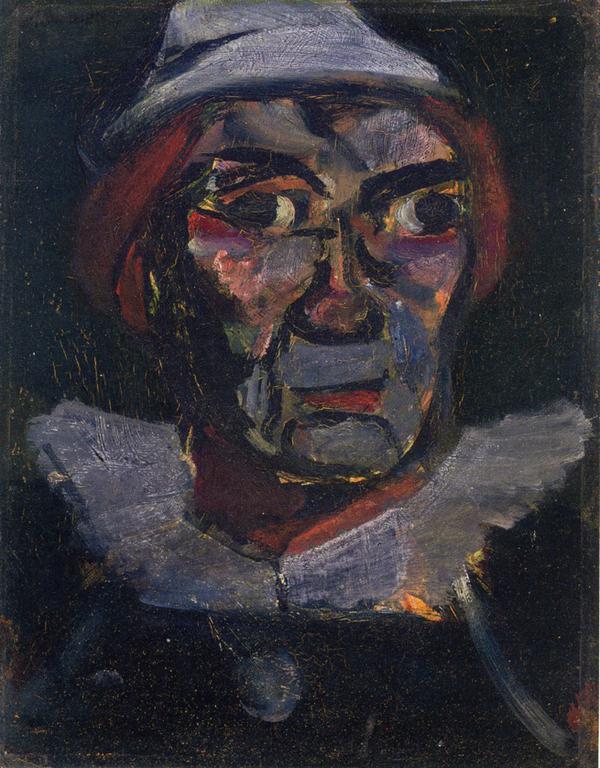
Figure de clown de face
Georges Rouault (1871 Paris - 1958 Paris)
1909
Huile sur carton ; signé « G. Rouault » en haut à gauche ; 22,2 x 17,1 cm
Provenance :
Londres, Zwemmer Gallery ; Londres, J. W. Freshfield ; Londres, Mayor Gallery ; Londres, Sotheby's, 1er décembre 1965 ; Londres, Arthur Tooth & Sons Gallery ; Palm Beach, Frieda Kittay Goldsmith ; New York, Christie’s, 4 novembre 2009 ; Paris, collection Le Polyptyque ; Paris, collection privée.
Exposition :
Summer Exhibition of Paintings and Sculptures of the 19th and 20th Centuries (Londres, O'Hana gallery, 1963).
Bibliographie :
Bernard Dorival et Isabelle Rouault, Rouault, l’œuvre peint, Monte Carlo 1988, n° 152.
Georges Rouault, de la même génération que Matisse qui comme lui fréquenta l’atelier de Gustave Moreau, suivit ensuite la voie très personnelle d’un expressionnisme fortement teinté de spiritualité qui le rendit célèbre dans le monde entier, notamment en Grande-Bretagne, aux États-Unis et au Japon.
Peu de peintres ont inspiré la critique comme Rouault en son temps. Peut-être faut-il, pour décrire sa peinture, l'accent shakespearien de Thomas MacGreevy dans le compte-rendu d'une exposition Rouault à la Zwemmer Gallery de Londres : « flaming darkly with the suffering of the world and the fiery glow of spiritual passion ». Rouault lui-même écrit en 1905 au critique Édouard Schuré : « Ce contraste de choses brillantes, scintillantes, faites pour amuser, et cette vie d’une tristesse infinie si on la voit d’un peu haut… Puis j’ai amplifié tout cela. J’ai vu clairement que le "pitre" c’était moi, c’était nous… » Ce « clown » sonne effectivement comme un autoportrait.
Nous sommes ici quelques années plus tard, probablement en 1909. Rouault délaisse l’aquarelle, rehaussée de pastel ou de gouache, pour l’huile sur carton, ou sur papier. Il a épousé Marthe, la sœur du peintre Henri Le Sidaner, l’année précédente. L’année suivante, il fera sa première exposition personnelle à la galerie Druet. Artisanal, se souvenant de l'art du vitrail qu'il pratiqua d'abord, inclassable, sinon dans le courant si souvent souterrain qui comprend le dernier Rembrandt, le premier Cézanne, et Fautrier, Rouault, osons ce mot usé jusqu'à la corde, nous « interpelle ».
Il est étrange de penser que ce tableau a hanté pendant quarante ans une somptueuse villa de Palm Beach, « âme de gothique » (disait le peintre et critique André Lhôte) égarée dans le monde éthéré que fixait en images le photographe Slim Aarons.
Il n’y était pas en mauvaise compagnie, puisque dans la même collection figurait le portrait d’Annette, de Giacometti, vendu 11 millions de dollars en 2007. Sa propriétaire, Frieda Kittay (1910-2007), francophile et cultivée, était la veuve d’un symbole vivant de l’Amérique du siècle dernier : immigrant pauvre, devenu multimillionnaire et philanthrope…
